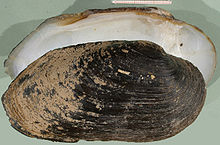- Spengler's freshwater mussel
-
Spengler's freshwater mussel 
A shell of Spengler's freshwater mussel from Spain Conservation status Scientific classification Kingdom: Animalia Phylum: Mollusca Class: Bivalvia Order: Unionoida Family: Margaritiferidae Genus: Margaritifera Species: M. auricularia Binomial name Margaritifera auricularia
Spengler, 1793Synonyms Unio auricularius Spengler, 1793
Pseudunio auricularia (Spengler, 1793)
Pseudunio auricularius auricularius (Spengler, 1793)[2]
Unio sinuatus Lamarck, 1819Spengler's freshwater mussel scientific name (Margaritifera auricularia or Pseudunio auricularia) is a species of European freshwater mussel, an aquatic bivalve mollusk in the family Margaritiferidae, the freshwater pearl mussels. It is named after Lorenz Spengler.
Contents
Description
Large shells are up to 180 mm in length.
Taxonomy
There are different opinions on the taxonomy of this species.
The species was originally described as Unio auricularius Spengler, 1793.
When it is placed in the genus Margaritifera Schumacher, 1816, it is considered to be:
- Margaritifera auricularia (Spengler, 1793)
At other times it is placed in the genus Pseudunio F. Haas, 1910, in which case it is known as:
- Pseudunio auricularia (Spengler, 1793)
Sometimes it is given the masculine gender:
- Pseudunio auricularius auricularius (Spengler, 1793)
Distribution
It is found in:
- France - recent distribution[2]
- Italy - recent
- Spain - recent[3]
- Portugal - recent(?) or fossil(?)[citation needed]
- maybe in some rivers in north Africa[4]: Marocco[5]
- Netherlands - extinct or fossil[citation needed]
- Belgium - extinct or fossil[citation needed]
- Luxembourg - extinct or fossil[citation needed]
- Czech Republic - only fossil records in layers with settlement from neolite: Ďáblice, Kobylisy, Roztoky, Podbaba.[5]
- United Kingdom - ?[citation needed]
Ecology
The fish hosts for the glochidium larvae of this species are: Salaria fluviatilis, Gambusia hollbrooki, Acipenser baerii, Acipenser naccarrii and Acipenser sturio.[4]
The hosts for this species were unknown for a long time: as recently as 1998 they were still not known.[6]
References
- ^ Seddon, M.B. 1996. Margaritifera auricularia. In: IUCN 2008. 2008 IUCN Red List of Threatened Species. <www.iucnredlist.org>. Downloaded on 05 November 2008.
- ^ a b Checklist of France. CLECOM. Check List of European COntinental Mollusca. Göteborg Natural History Museum (Göteborgs Naturhistoriska Museum). Last change: 23 May 2008. Accessed 5 November 2008.
- ^ Araujo, R. & Ramos, M. A. 1998. Margaritifera auricularia (Unionoidea, Margaritiferidae), the giant freshwater pearl mussel rediscovered in Spain. Graellsia, 54: 129-130.
- ^ a b c F. Welter Schultes. 2008. Margaritifera auricularia. AnimalBase. Last modified 23-10-2008. Accessed 5 November 2008.
- ^ a b Ložek V. 1964. Quartärmollusken der Tschechoslowakei. Rozpravy Ústředního ústavu geologického, Vol. 31, Nakladatelství ČSAV, Praha, volume 31, 374 pp., 32 tables, 4 supplements, page 317. (in German)
- ^ Araujo, R. & Ramos, M. A. 1998. Description of the glochidium of Margaritifera auricularia (Spengler, 1793) (Bivalvia, Unionidae). Philosophical Transactions of The Royal Society of London B, 353: 1553-1559.
Further reading
- Araujo, R & Moreno, R. 1999. Former Iberian Distribution of Margaritifera auricularia (Spengler) (Bivalvia: Margaritiferidae). Iberus, 17(1): 127-136.
- Araujo, R., Bragado, D. & Ramos, M. A. 2000. Occurrence of glochidia of the endangered Margaritifera auricularia (Spengler, 1793) and other mussel species (Bivalvia: Unionoida) in drift and on fishes in an ancient channel of the Ebro River, Spain. Archiv für Hydrobiologie, 148(1): 147-160.
- Araujo, R. & Ramos, M. A. 2000. A critic revision of the historical distribution of Margaritifera auricularia (Spengler, 1793) (Mollusca: Margaritiferidae) based on museum specimens. Journal of Conchology, 37(1): 49-59.
- Araujo, R. & Ramos, M. A. 2000. Status and conservation of the relict giant European freshwater pearl mussel Margaritifera auricularia (Spengler, 1793). Biological Conservation, 96(2): 233-239
- Grande, C., Araujo, R. & Ramos, M. A. 2001. The gonads of Margaritifera auricularia (Spengler, 1793) and Margaritifera margaritifera (L. 1758) (Bivalvia: Unionoidea). Journal of Molluscan Studies, 6: 27-35.
Araujo, R., Bragado, D. & Ramos, M. A. 2001. Identification of the river blenny, Salaria fluviatilis, as a host to the glochidia of Margaritifera auricularia. Journal of Molluscan Studies, 67: 128-129.
- Araujo, R., Cámara N. & Ramos, M. A. Glochidium metamorphosis in the endangered freshwater mussel Margaritifera auricularia (Spengler, 1793): A histological and scanning electron microscopy study. Journal of Morphology. 254: 259-265.
- Araujo, R., Quirós, M. & Ramos, M. A. 2003. Laboratory propagation and culturing of juveniles of the endangered freshwater mussel Margaritifera auricularia (Spengler, 1793). Journal of Conchology. 38(1): 53-60.
- Araujo, R. 2004 Two overlooked host fish species of Margaritifera auricularia (Bivalvia, Unionoidea, Margaritiferidae). Basteria, 67: 113.
- Vallejo, A., & Araujo, R. The Historical misidentification of Margaritifera auricularia for M. margaritifera (Bivalvia, Unionoidea) explained by their iconography. Malacologia. (in press)
- Araujo, R. & Ramos, M. A. 2001. Action Plan for Margaritifera auricularia. Convention on the Conservation of European Wildlife and Natural Habitats (Bern Convention). Council of Europe Publishing. Nature and environment, No. 117. Strasbourg. 28 pp.
- Araujo, R. & Ramos, M. A. 2001. Life-History data on the virtually unknown Margaritifera auricularia. En: Ecological Studies, Vol. 145. "Ecology and Evolution of the Freshwater Mussels Unionoida" ed. by G. Bauer and K. Wächtler. Springer-Verlag Berlin Heidelberg. 143-152. Por invitación.
- Araujo, R. & Ramos, M. A. 2001. Margaritifera auricularia. En: Los Invertebrados no Insectos de la "Directiva Hábitat" en España. Serie Técnica. Ed. Organismo Autónomo Parques Nacionales (Ministerio de Medio Ambiente). Madrid. 93-101.
Categories:- IUCN Red List critically endangered species
- Margaritifera
- Margaritiferidae
Wikimedia Foundation. 2010.


